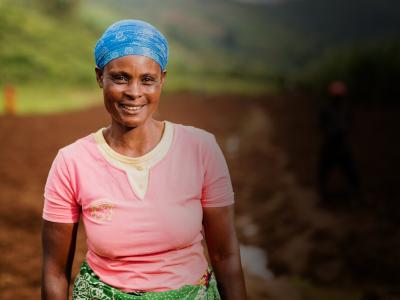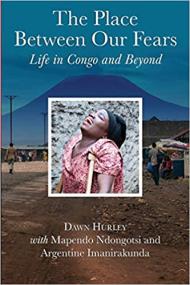Welcome to the Women for Women International Book Club! This month we’re reading The Place Between Our Fears: Life in Congo and Beyond by Argentine Imanirakunda, Dawn Hurley, and Mapendo Ndongotsi.
Written by the founders of SHONA Congo, The Place Between Our Fears follows the experiences of the three women navigating life in eastern Congo and "walls" like conflict, health care access, infrastructure, and poverty. Argentine and Mapendo are committed to sharing what happened so the world will remember the many people still living within those walls and the role of community in breaking them.
What is The Place Between Our Fears about?
The Place Between Our Fears follows the friendship between the three authors — Argentine, Dawn, and Mapendo — and the power that community plays in helping women overcome barriers. The book begins with Dawn's experiences moving to Goma, a city in the Democratic Republic of the Congo.
Like Dawn, Argentine and Mapendo had moved to Goma but their reasons differed: Argentine and Mapendo fled the violence of the rebel militias roaming eastern DRC, seeking medical treatment and safety in the city. Between national disasters, violent conflict, and shaky means to earn livelihoods, stability for many people living in the Congo is a fragile thing.
During their time together, Argentine, Mapendo, and other women from their community form "SHONA Congo," a group sewing bags and dresses to sell in the United States through Dawn. As Dawn returns to the U.S., the book illustrates the many barriers to migration and movement facing people in the Congo: stay in hard-earned homes surrounded by rebel soldiers or risk danger for a chance at safety elsewhere.
Several times, Argentine and Mapendo attempt to leave Goma, their journeys made complicated by funds, transportation, their disabilities, and even motherhood. In the chaos, their families are sometimes separated but thankfully often reunited. Eventually, Argentine and Mapendo become refugees. Within the camps are another set of challenges in terms of the resources available and that refugees were able to bring with them.
Women across the world, brought together by the community built through SHONA Congo, supported Argentine and Mapendo by helping them resettle in Canada. Today, Argentine, Mapendo, and Dawn continue SHONA Congo with Riziki and Solange, who are rebuilding their lives in Goma. The Place Between Our Fears asks people not to forget women living amidst conflict in the DRC while showing what's possible through women's solidarity and strength.
Discussion Questions
Check out the discussion questions below and connect with readers on Instagram to share your reactions, thoughts and questions by using the hashtag #WFWIBookClub, and tagging us with @womenforwomen. We want to hear what you think—share with us your take on the book!
Part I
- The majority of Part I takes place in the city of Goma. What are some of the positive aspects of life in Goma? What are some of the difficulties?
- The story of Mama Kavira and the bread provides a touchstone throughout the book. What do you think the incident is really about?
- Argentine and Mapendo both face difficult childhoods. In what ways do they face similar challenges? In what ways do they face different challenges?
- What do you think are the primary lessons that Argentine and Mapendo might have learned from their experiences in Part I? What do you think are the primary lessons that Dawn has learned in Part I?
Part II
- This part of the book is dedicated to describing the many ways that Argentine and Mapendo are displaced from their homes (fleeing around the lake, fleeing to Burundi, fleeing to Uganda). In what ways do their experiences of displacement look different than you might have imagined?
- How does the author's friendship with Argentine and Mapendo change during this section?
- It could be said that this is a book about motherhood. Discuss the role of mothers in Part I and Part II.
- What surprised you about the refugee camps in Burundi and Uganda? What are some of the biggest challenges that Argentine and Mapendo faced in those camps?
- Before reading Part III, what did you anticipate might be some of the biggest challenges that Argentine and Mapendo and their families would face in Canada?
Part III
- What are some of the things that Argentine, Mapendo and their families seem to appreciate most about Canada? What are some of the challenges they face?
- At the end of chapter ninety-three the author writes, "I see Aline, Ziada, and Neema poised with their toes pressed to the edge of this line, trying their best to hold it all together; to make sense of a world that offers vastly different futures to some of its children than to others." What are some ways that you see this disparity in the world? How do you see it in your own community?
- What is your favorite story from Part III and why?
- In what ways do the lives of Argentine and Mapendo build in Canada reflect Congolese culture and values? In what ways do they seem to have changed to adapt to life in Canada?
- In the end of the book the author writes, "Mapendo once said, 'In Goma we learned to pull ourselves toward each other. We had no other choice.'" Looking at Argentine and Mapendo's experiences throughout this book, in what ways has their security and safety been tied to community?
- In reference to the United States, the author concludes, "We have come to believe the myth of self-built security, as though security can exist apart from community." In what ways would you say this is true or untrue in the context where you live?
- What was your biggest take-away from this book?
The discussion questions above are printed in the 2019 edition of The Place Between Our Fears: Life in Congo and Beyond published by SHONA Congo.

